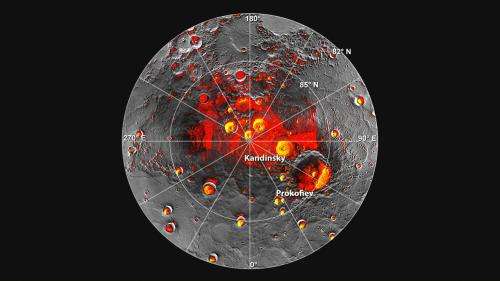Altimeter built at Goddard helped identify ice on Mercury

A Goddard-built instrument on NASA's MESSENGER mission provided one of three new lines of evidence that water ice exists near the north pole of Mercury. Most of the ice is covered by a thin layer of material that blankets and protects the ice, but in a few areas where sunlight never reaches, some ice lies exposed on the surface, the researchers announced Nov. 29 in three papers published by Science Express and at a NASA press conference.
The findings are based on reflectance measurements made by the spacecraft's laser altimeter and hydrogen concentrations from the neutron spectrometer as well as new computer modeling that explains how ice could persist for eons on the planet closest to the sun.
"Twenty years ago, radar astronomers made the startling proposal that there is abundant water ice at the poles of our solar system's innermost planet," says Sean Solomon of Columbia University. "But alternative explanations of the radar observations have since been suggested, and the MESSENGER team set a high priority on settling this question with orbital observations. The jury has at last returned a clear verdict." Solomon is the principal investigator for MESSENGER (short for MErcury Surface, Space ENvironment, GEochemistry, and Ranging).
Despite Mercury's proximity to the sun, the north and south polar regions remain cold because they never tilt toward the sun. Evidence for ice deposits at both poles has been building since the early 1990s, when radar studies first spotted areas that looked very bright at radar wavelengths. These "radar-bright" regions suggested that some kind of reflective material lay on or very near the surface, and the locations turned out to be inside impact craters. More recently, extensive imaging by MESSENGER made it possible to match up the radar-bright areas with permanently shadowed regions in craters near the north and south poles.
The new studies focused on Mercury's north pole and the surrounding high latitudes. When researchers measured the reflectance at near-infrared wavelengths using the altimeter, they found more than a hundred dark regions, which reflected less than half the typical amount of light. A few exceptionally bright areas also were detected in the craters named Prokofiev and Kandinsky.
"Nobody had seen these dark regions on Mercury before, so they were mysterious at first," says Goddard's Greg Neumann, lead author of one of the papers in Science Express and an instrument scientist for the Mercury Laser Altimeter. This instrument was built at NASA's Goddard Space Flight Center in Greenbelt, Md.
Because the altimeter's main task is to map the contours of the planet's surface, Neumann and colleagues could see that these unusually dark areas occurred in places that stayed in shadow: on steep crater walls that faced the north pole or on the southern parts of crater floors. The researchers also matched up their dark regions with the reflective areas that looked bright to the radar signals. The regions that appeared radar-bright and unusually bright to the altimeter were located in places that never emerged from shadow.
In the meantime, measurements of hydrogen concentrations made by MESSENGER's Neutron Spectrometer indicated that the radar-bright deposits were water ice. David Lawrence of the Johns Hopkins University Applied Physics Laboratory in Laurel, Md., and colleagues found that the radar-bright areas contain a hydrogen-rich layer buried beneath a layer with less hydrogen.
The results from both instruments made sense if these radar-bright regions (also the altimeter's dark regions) represented water ice covered by a layer of other material. The much rarer bright regions seen by the altimeter would then indicate ice exposed on the surface.
Computer modeling by David Paige of the University of California, Los Angeles, and colleagues showed that Mercury's average temperatures in these areas are low enough for ice to be stable over time. A blanket of insulating material is needed to maintain ice in the altimeter's dark regions, but other spots receive so little sunlight that ice could persist right on the surface.
The ice seems to be the result of a geologically recent or ongoing process, perhaps delivered by comets and other small bodies from the outer solar system. Organic chemicals from those same bodies might make up the material that covers the ice in most places. More work needs to be done before these follow-on questions can be answered definitively.
"But these new findings let us discard the proposals that the radar might be picking up other reflective materials instead of ice," says Neumann. "Now we can focus on understanding the processes that are emplacing volatiles at Mercury's poles."
Journal information: Science , Journal of Geophysical Research , Science Express
Provided by NASA's Goddard Space Flight Center




















